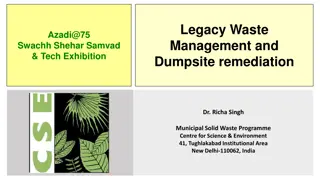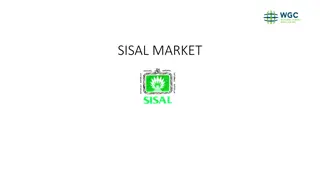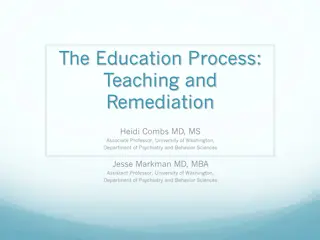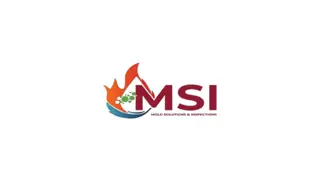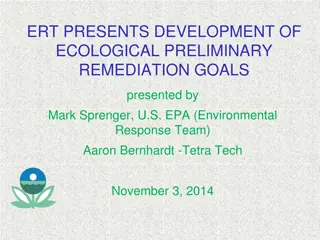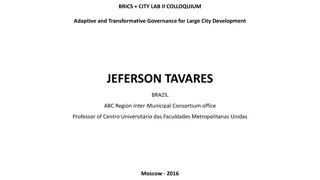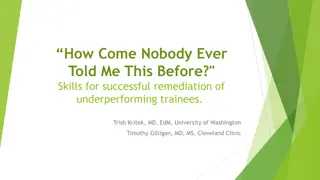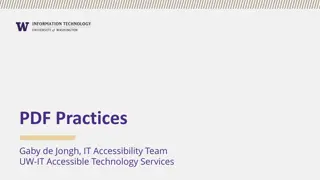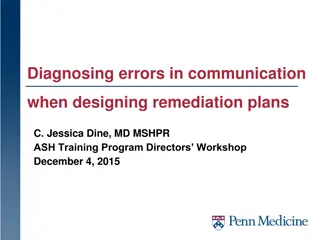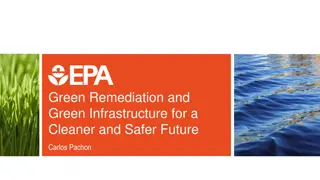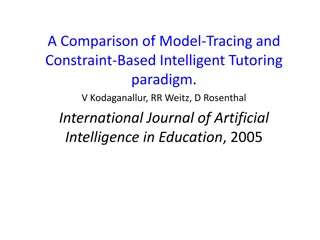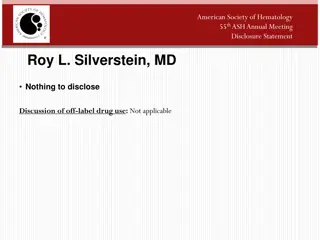Sustainable Remediation in Brazil: Development, Controversies, and Future Perspectives
This content delves into the sustainable remediation practices in Brazil, highlighting the development, controversies, and future outlook. It discusses strategies, challenges, and the evolving landscape of contaminated site management, emphasizing the need for sustainable remediation solutions. The focus is on maximizing environmental, social, and economic benefits while addressing unacceptable risks effectively and efficiently.
Download Presentation

Please find below an Image/Link to download the presentation.
The content on the website is provided AS IS for your information and personal use only. It may not be sold, licensed, or shared on other websites without obtaining consent from the author.If you encounter any issues during the download, it is possible that the publisher has removed the file from their server.
You are allowed to download the files provided on this website for personal or commercial use, subject to the condition that they are used lawfully. All files are the property of their respective owners.
The content on the website is provided AS IS for your information and personal use only. It may not be sold, licensed, or shared on other websites without obtaining consent from the author.
E N D
Presentation Transcript
Sustainable remediation in Brazil: Development, controversies, and future perspectives Juliana G. Freitas, Stela Cota
Contaminated sites management Beginning 1st generation Complete removal pollutants 3rd gen Sustainable management 4th 5th gen? - Nature based Solutions - Prevention / Control 2nd gen Risk based approach Slenders et al., 2017 DOI: 10.1002/rem.21509 1970 1980 1990 2000 2010 2020 Beginning 3rd gen 2nd gen Federal legislation State guideline values First regulations and guidelines First contaminated sites identified 4th 5th gen? Risk assessment spreadsheets
Contaminated sites management in Brazil Strategies and actions are very heterogeneous in Brazil Half of the Brazilian states did not have a methodology for contaminated site management 5 years after federal legislation Only 3 states have a register of contaminated sites Is there an organizational structure for contaminated sites management? Number of contaminated sites in the country is still largely unknown no partially yes ??? Texeira et al., 2016 (Panorama GAC - IPT)
Sustainable remediation Remediation 2aryimpacts Sustainable Remediation that eliminates and/or controls unacceptable risks in a safe and timely manner, and which maximize the overall environmental, social, and economic benefits of the remediation work (Surf- UK, 2010). one that represents the best solution when considering environmental, social, and economic factors - as agreed by the [project] stakeholders (Nicole, 2011) UN, 2016
Sustainable remediation in Brazil 1600 Remediation in S o Paulo State 1400 1200 1000 800 600 Total in 2023: > 6800 sites Thermal: 2 in 2017, 11 in 2023 400 Air sparging 200 Is sustainability playing a role in technology selection? 0 Jan-04 Oct-06 Jul-09 Apr-12 Dec-14 Sep-17 Jun-20 Mar-23
Remediation end-point How much should we remediate? Safe Sustainable Total removal General maximum acceptable values Site-specific risk assessment Compensation for contaminants left? What is an acceptable risk?
Remediation end-point How much is acceptable? Probabilistic approach carcinogenic compounds: 10-5 hazard quotient for non-carcinogenic: 1 dose limit criteria for radionuclides: 1 mSv yr-1 Who decides? what is acceptable should be defined by those who experience the risk
At which step we consider sustainability? Nowadays Technology selection Deciding how to apply the selected technology Example: using solar panels to operate a remediation system instead of the energy supplied by the power company
How we evaluate / compare sustainability Different sustainability assessment tools developed by consultant companies industry, academy? Validation? Indicators Environmental Economic Social? UN, 2016 No national or state guidelines available
Stakeholders engagement All stakeholders should be involved Stakeholders must be listened to during the first steps of contaminated site management Risk communication: mentioned in national and state regulations, but no clear definitions on how and by whom Lack of transparency Mariana dam disaster CBH Rio das Velhas
Lack of local studies Lack of research and studies on sustainable remediation in Brazil Low number of publications on sustainable remediation by developing countries, particularly Brazil Sustainability assessments and comparison tools majority developed in Europe and the US Sustainable remediation Peer reviewed articles Scopus
Future perspectives Some good news Initiatives: NICOLE Latin America Work group on Sustainable remediation CETESB Review of the Contaminated Sites Management Guidance S o Paulo State Environmental Chamber for Contaminated Sites Management Nature-based Solutions
Future perspectives Discussions in different settings, institutions and groups of stakeholders are happening Rarely involve the ones affected or potentially affected by the risks Unidirectional communication: experts impacted community For contaminated sites, sustainability should: Be considered from the start Involve all stakeholders We need an integrated perspective considering ecological and societal settings
Acknowledgements Thank you!



![Halal_Chicken_from_Brazil-_Ensuring_Quality_and_Authenticity[1]](/thumb/86918/halal-chicken-from-brazil-ensuring-quality-and-authenticity-1.jpg)
